Top News
June 14, 2013 Wu Li Jun of Ryukyu Shimpo
China Eastern Airlines has increased its Shanghai – Naha flights from four round-trips a week to one per day. With relations between Japan and China deteriorating over the Senkaku Islands issue, since September 2012 the company had reduced the number of flights on this route. From July 3, China International Airlines will revive its direct flight between Beijing and Naha, which offers two round-trips per week on Wednesdays and Saturdays. Air routes connecting China and Okinawa have shown signs of improvement.
A spokesperson of the Okinawa branch of China Eastern Airlines explained, “China has its Golden Week holiday this month and tourist interest there in Okinawa’s summer season has increased. We have decided to resume our daily flights.”
Flights from Shanghai to Okinawa are now running at 80 to 90 percent of capacity and there is strong demand for reservations in July and August.
Among other airlines’ direct flights between Okinawa and China, Hainan Airlines has suspended the start of its planned Beijing – Naha route and Juneyao Airlines has postponed the opening of its Shanghai- Naha route.
Since last October, China Eastern Airlines has decreased its flights to four round-trips per week, but offered a daily service at times such as the Spring Festival (Chinese New Year). China Eastern Airlines is the first company to resume its service to the same level as before the Senkaku dispute affected relations.
Hainan Airlines and Juneyao Airlines do not plan to fly on the route in the immediate future.
(English translation by T&CT, Mark Ealey)
Go to Japanese
June 19, 2013 Ryukyu Shimpo
Construction workers have unearthed dozens of barrels bearing the words: “The Dow Chemical Company” at a soccer ground on land returned by the U.S. military in Okinawa City. The United States based company is the second-largest chemical manufacturer in the world. During the Vietnam War they produced Agent Orange, a chemical defoliant containing dioxin.
The discovery has increased the possibility that the U.S. military stored the defoliant in Okinawa.
The U.S. government has consistently claimed that no evidence exists of storage of Agent Orange, but will they continue to do so despite this latest find?
In 2007, the U.S. Department of Veterans Affairs (VA) acknowledged that veterans’ health had been affected by exposure to defoliant sprayed in the Northern Training Area.
Claiming that the military exposed them to the defoliant during their stay in Okinawa, in 2011 more than 100 veterans filed claims to the VA for damage to their health.
A report produced by the U.S. Army Chemical Materials Agency in 2003 said the military stored 25,000 barrels of Agent Orange in the prefecture until its reversion to Japanese administration in 1972. There is a great deal of evidence that Agent Orange was stored on Okinawa.
In March this year the U.S. Department of Defense released the results of an investigation on defoliants in Okinawa. It stated that the military had placed strict controls on the storage of the defoliant, and that no evidence could be found of Agent Orange being transported to Okinawa.
It is suggested that the retired U.S. Air Force colonel in charge of compiling the report received research funding from the manufacturers of the defoliant. We cannot blindly accept the results of such a report.
We also cannot help but wonder about the Japanese government’s attitude on the issue. To date, they have not asked the U.S. government to carry out any joint investigations on the Agent Orange issue in Okinawa, including soil tests.
When U.S. Army veterans alleged that they buried Agent Orange in South Korea in 2011, the U.S. military and South Korean government initiated a joint investigation two weeks after the media reported the allegations.
The U.S. and Japanese governments’ double standards on the issue is unacceptable. More than 100 veterans have stated that Agent Orange existed on military bases in Okinawa.
In the past, construction workers unearthed many barrels in Chatan on land returned by the military. It is clear that the U.S. military did not operate the bases in Okinawa in a proper manner.
No matter how much the U.S. government continues to deny the existence of Agent Orange in Okinawa, the Okinawan people will never trust nor accept their statements.
The U.S. and Japanese governments should move swiftly to carry out a joint investigation. A large-scale investigation is required, including earth excavation on land returned by the military and in the bases where they possibly buried Agent Orange.
(English translation by T&CT, Mark Ealey)
Go to Japanese
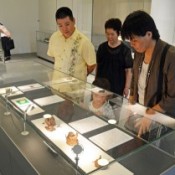
June 14, 2013 Masaaki Umeda of Ryukyu Shimpo
Every June, the Okinawa Prefectural Peace Memorial Museum in Mabuni, Itoman, holds the “New Artifacts Exhibition” to display items that individuals and groups have recently donated. However, because the museum has not received as many items in recent years, it will soon become difficult to hold the exhibition on an ongoing basis. A staff member expressed his concern, saying, “This is a serious problem in terms of passing on memories of the Battle of Okinawa.” One scholar suggested that the museum should consider displaying existing materials from different viewpoints.
The museum could not hold the exhibition last year because they were not able to collect enough items, but by this March they had received enough items from several groups to hold it from June 13.
The museum has a total of about 40,000 war-related materials, which is the most extensive collection in Okinawa. From fiscal year 2004 to 2008, they received 200 to 300 materials and in 2009, the Bereaved Families Association gave the museum about 3,000 items, but the number of new artifacts received has decreased by about 100 every year from 2010 to 2012. This year, the museum is able to hold the exhibition because the non-profit organization One-foot Film Movement, which disbanded in March, provided 107 items. They only received two items this April, so it is uncertain if they will be able to run the exhibition next year.
Chief curator Masaki Higa said, “As the number of precious items that convey the reality of the Battle of Okinawa decreases, researching the war and passing on its memories to the next generation becomes more difficult. We would like to encourage people to donate more materials.”
“Now, in 2013, 68 years after the end of the war, I think it is only natural that donations of new items are decreasing. We need to display existing materials from a fresh viewpoint, as well as trying to collect new items,” said Professor Shinobu Yoshihama, a researcher of the Battle of Okinawa at Okinawa International University.
The exhibition displays 207 precious items, including a tin can (an improvised explosive device) filled with nails. It runs until the end of July and admission is free.
(English translation by T&CT, Lima Tokumori and Mark Ealey)
Go to Japanese
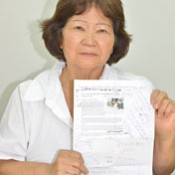
June 13, 2013 Ryukyu Shimpo
On June 12, Katsue Shingaki Garner, a 75-year-old resident of Georgia, United States, who is originally from Nishihara Cho, added her name to the list of plaintiffs in the lawsuit called Nuchidu-Takara. The group seeks an apology from the central government and compensation for civilian casualties in the Battle of Okinawa. She lost both her parents in the war – her mother in the Battle of Okinawa, and her father in an air raid on Palau. Shingaki is the first person living abroad to join this collective lawsuit. The fourth group of plaintiffs, including her, will file the suit with the Naha District Court on August 15.
Her father Kama was killed at Palau in an air raid on October 13, 1944, and her mother Hideko died in the former Ozato Village (now Nanjo City), on June 10, 1945. Shingaki moved to the United States in 1965. She learned of the lawsuit when her daughter read the article on the Ryukyu Shimpo English news site about the press conference held in December 2011 covering the Okinawa War Victim Group.
Shingaki said, “I want to let other people to know about the lawsuit, and for them to speak up and be heard.”
A total of 63 people joined the plaintiff group for the first, second and the third lawsuits. Shigeru Zukeyama, the lead attorney of the War Victim Group said, “If many people come together and raise their voices, public opinion will move. We want those people who hesitate to come forward to join us.”
Inquiries should be directed to the Zukeyama Law Office (phone) 098 (833) 7447.
(English translation by T&CT, Mark Ealey)
Go to Japanese
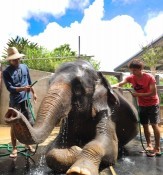
June 14, 2013 Ryukyu Shimpo
The Okinawa Meteorological Observatory announced on June 14 that the rainy season in Okinawa has ended.
The rainy season in the region usually continues until around on June 23, so it has ended nine day earlier than usual.
This year, the Okinawa region’s rainy season started on May 14 and lasted for 31 days, which is the fifth shortest season since data began to be collected in 1951.
(English translation by T&CT, Mark Ealey)
Go to Japanese

Go To Video

June 14, 2013 Ryukyu Shimpo
This year, Shinkichi Kinjo, manager of the Okinawa Shogaku High School boxing club, will close the Winner Boxing Gym, which he has been running for the last 30 years in Shuri, Naha. The gym has turned out many famous boxers and has had a significant impact on Okinawan boxing history. Having seen the gym’s boxing ring covered in the sweat and tears of many boxers, Kinjo said, “I am grateful to have met so many children and that so many people have supported the gym.”
Kinjo was a boxer at Southern Agricultural and Forestry High School and Nihon University. He worked as the manager of the boxing club at Konan High School for 29 years from 1969 and at Okinawa Shogaku High School after that. He produced many national champions in invitational tournaments, inter-school championships and national sports festivals. Kinjo taught the fundamentals to many boxers who turned professional and became champions both inside and outside of Japan. They include Yoko Gushiken who was WBA Light Flyweight champion from 1976 to 1981 and Akinobu Hiranaka who won the WBA Light Welterweight title in 1992.
Kinjo put in his own money to make the gym by renovating his house.
Working with his wife, Kiyoko, who died three years ago, Kinjo has supported many boxers in the pursuit of their dream. Boxers from outside Okinawa came to seek coaching from Kinjo and he often let them train in his gym.
Kinjo decided to close his gym because it provides a venue for practice for Okinawa Shogaku High School, which will wind up its boxing club this year. Soon to turn 70 years old, he said that his advancing age is another reason behind his decision.
Many people know Kinjo as a strict taskmaster. His approach originated in his college days before Okinawa’s reversion to Japanese administration. Kinjo sensed the gap between Okinawa and the main Islands of Japan and became hungry to win; hence naming his gym “winner.” On the wall in the gym he posted the expression: “You must win against yourself before winning in a fight. Cry in practices and smile after fights.”
Kinjo is a compassionate character. He said, “It’s not all about results. I am happy if when my students go on to become a member of society, or parents, they feel that boxing was good for them.”
He talked about the sadness of closing the gym, saying, “I could even say that it is like part of me.”
Kinjo will continue to work for boxing. He has been the manager of the Toyo University Boxing Club since 2011 and works for the Okinawa Prefectural Boxing League. He said, “I am still passionate about boxing and love the sport.” Many people honor Kinjo by referring to him as the likes of “a legendary trainer,” “a fierce trainer” and “a smart trainer.” Sixty-eight-year-old Kinjo still keeps a close eye on the sport.
(English translation by T&CT, Mark Ealey)
Go to Japanese
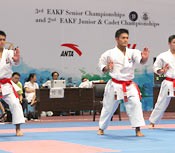
June 10, 2013 Ryukyu Shimpo
In the 3rd East Asian Senior Karate Championship, which began on June 8 in Wuhan, China, Japan won all the Kata divisions for individual men, women, and teams. Okinawan Ryo Kyuna (Ryueiryu) has now won two consecutive years in the men’s Kata Individual Division. He is also a member of the Japan team (including Takuya Uemura and Arata Kinjo of Okinawa International University), which came first in the Kata Team Division. Japan won convincingly 5-0 against both the Taiwanese senior team in the first round and the Taiwanese junior team in the final. They performed the Suparinpei kata in the first round of the tournament and the Annan kata in the final. Kyuna lost just one point in the first round in the Kata Individual Division, going on to defeat his Korean opponent in the semifinal and the representative from Macau in the final.
Kyuna aims at the world stage
Gold medals shone on the chests of the Okinawan karate men who have inherited the tradition of the Ryueiryu. The Japanese team of three men from Okinawa overwhelmed their opposition with a near perfect performance. Kyuna, who was victorious in both the individual and team events, said, “I think that I went well, and I won good marks. I think that I made a statement ahead of the next international tournament.”
In the Kata Team Division, the Japanese team of Kyuna, Uemura and Kinjo comfortably defeated the other teams 5-0 in the first round and in the final. Kyuna said, “I think that we were better that our opponents in all the key aspects of power, speed, spirit, and basic technique.” Kinjo was injured a month ago, but they worked together to overcome this, and their teamwork became stronger as a result.
Kyuna took part in many international competitions last year and now aspires to win on the world stage. While he has rivals within Japan, he says, “I want to be selected to represent Japan at the Asian and then the World tournaments.”
(English translation by T&CT, Mark Ealey)
Go to Japanese
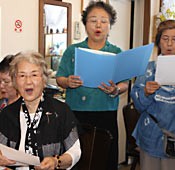
June 7, 2013 Ryukyu Shimpo
A song that 86-year-old Naha resident Teruko Omine wrote as a memorial to her friends who died during the Battle of Okinawa as Himeyuri nurse-aides is arousing people’s sympathy. Omine attended the former Okinawa Daiichi Women’s High School, which was located at Asato district in Mawashi Village (now Naha), but avoided the fighting in Okinawa because she went to Tokyo in April 1944 to study.
After returning to Okinawa, Omine has lived her life cherishing the memories of her deceased friends. The stories that she heard from people who survived the battle had a strong impression on her. “I hate war. If the war hadn’t happened, they would have had led happy lives with families, eventually being surrounded by grandchildren and great-grandchildren,” Omine said, fighting back tears of emotion.
Omine wrote the song titled Himeyuri about two years ago, singing it to the tune of the famous Japanese song Hamabe no Uta (The Song of the Seashore). Toshiko Taira, the 80-year-old leader of the choral group Tanpopo that Omine belongs to, composed some original music for Himeyuri. In addition to Tanpopo, this song has become a popular piece for another two groups in which Taira gives singing lessons.
The song starts with the phrase, “Fragrant lily blooming bravely in the embrace of the school garden in Asato.” It continues on to a verse about the girls in the Himeyuri Student Corps who received a kominka education that stressed the raising of citizens as loyal subjects believing in victory and willing to give their lives for their country and for the Emperor.
In the last verse, as they think about their old friends who lost their lives at the southern tip of Okinawa’s main island, the survivors vow to become storytellers who convey love and an anti-war message to the world.
“Survival during the war was just a matter of the luck of the draw. Many who came through it have a sense of guilt and unease about friends who died,” Omine said.
Some of the choral group members shed tears while humming the song Himeyuri during their practice. “I felt myself trembling when I read the words. The words for the song came into my head in one night. I would like to continue singing this long into the future,” Taira said.
(English translation by T&CT, Mark Ealey)
Go to Japanese
June 8, 2013 Ryukyu Shimpo
On June 7, the Okinawa Prefectural Government (OPG) announced the results of a survey on international tourists’ level of satisfaction with tourism in Okinawa in fiscal 2012. Revenue from tourism increased 36 percent to 22.7 billion yen because in comparison to the previous year foreign tourist numbers went up by 26.9 percent to 382,500.
The number of tourists flying to Okinawa increased by 30.7 percent to 238,500. Revenue for this category increased by 38.7 percent to 19.8 billion yen. The number of tourists traveling by sea increased by 21.1 percent to 144,000 with revenue going up by 20.1 percent to 2.8 billion yen.
The number of Taiwanese visitors to Okinawa by air and sea was the largest among the origins of foreign tourists.
The Chinese were the biggest spenders. Each Chinese person flying to Okinawa spent 125,181 yen as opposed to 18,993 yen spent by each traveling by sea.
Taiwanese visitors coming to Okinawa by air spent a total of about 6 billion yen with about 10.8 billion yen spent by those who came by sea. Some 85,600 Taiwanese tourists flew to Okinawa, with 47.6 percent of them coming on group package tours. The largest portion of their spending went on confectionery and medicinal products.
Chinese visitors to Okinawa who came by air spent about 3.8 billion yen with about 541 million yen spent by those by sea. The majority of those flying to Okinawa came on group tours. They spent the most on cosmetics, perfume and electrical products.
Most of the tourists from Hong Kong flew to Okinawa, spending about 5.4 billion yen during their stay. They were the biggest spenders on food and drink, on which each of them spent an average of 24,579 yen.
South Korean visitors to Okinawa spent about 2.9 billion yen. They spent money on beauty salon treatments and were the biggest buyers of alcohol products.
The OPG surveyed the foreign tourists arriving by air and sea. They questioned tourists flying into Okinawa at Naha International Airport Terminal Building during the period from April 26, 2012 to January 15, 2013. The OPG collected 2328 responses. Tourists traveling by sea were surveyed at the Wakasa Cruise Ship Berth in Naha during the period from June 26, 2012 to November 4, 2012. The OPG collected 969 responses from this category of tourist.
(English translation by T&CT, Mark Ealey)
Go to Japanese
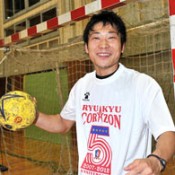
June 6, 2013 Noriko Oshiro of Ryukyu Shimpo
A doctor has joined the ranks of Japan’s top handball players. Shogo Nakamura, 30, from Iwate Prefecture, has passed the tryout for Ryukyu Corazon, a team in the Japan Handball League. He came to Okinawa on June 4 and joined the other members of the team. “I received a great deal of encouragement in my home prefecture of Iwate. I will work hard to live up to their expectations.” Still rejoicing at the news, he now prepares to move to a new stage in his life.
Nakamura started playing handball when he was in high school. He then joined the Faculty of Medicine handball team after being accepted into Akita University. After graduating in 2009, he worked as a doctor specializing in anesthesia and internal medicine at a hospital in Morioka while continuing to play handball with his high school old boys’ team and at a club.
Nakamura did not achieve anything notable during his school days such as playing in a national tournament. He said, “The national league is a totally different world for me. It never even crossed my mind that I would ever be able to play there.” However, after he started working, even though the amount of free time he had to practice handball was limited, his desire to play grew even stronger. Whenever he had time, he would ask his high school team’s coach for permission to join their training sessions.
Nakamura said that he found out about this tryout through the Ryukyu Corazon’s website. He reserved a flight ticket to Okinawa immediately, saying, “I would have regretted it if I had given up without even trying, thinking that I couldn’t have made it anyway.” Nakamura displayed his speed and jumping ability at the trial to evaluate players’ running ability, skills and on-court movements. A person involved with the team said, “He had the best results and we were impressed by his enthusiasm,” and so he was chosen as one of two successful candidates.
For the time he is in Okinawa, he will concentrate on handball without working as a doctor. Expressing his enthusiasm, he said, “I am fine playing in any position as long as I can get on the court to play.” Ryukyu Corazon finished a record fifth in the league last season, just shy of a spot in the playoffs. “I want to be one of the players on the court at the moment we become number one in Japan,” Nakamura said. With his dream on the line, the 2013-14 season will start in September.
(English translation by T&CT, Lima Tokumori and Mark Ealey)
Go to Japanese
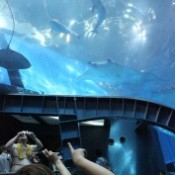
June 4, 2013 Ryukyu Shimpo
On June 1, a spotted dolphin in the large main aquarium Kuroshio Sea has been open for public viewing at Okinawa Churaumi Aquarium in Motobu.
This is the time for the Okinawa Churaumi Aquarium to put a dolphin in this tank. It provides a valuable insight into the ecological system.
Spotted dolphins were transferred from the Taiji Whale Museum & Aquarium in Wakayama. The two on show to the public now are a male and a female. One more dolphin will join the aquarium Kuroshio Sea when it is ready.
Dolphins are the superstars of the show at the Ocean Expo Park but until now have never had the opportunity to be with whale sharks and other fish in the main tank that makes the aquarium so famous. Sub-leader of fish team Yoshiyuki Nakazato said, “We want to replicate natural ecological systems, and at the same time, we want to investigate how fish and mammals living together.”
(English translation by T&CT, Hitomi Shinzato and Mark Ealey)
Go to Japanese









 Webcam(Kokusai Street)
Webcam(Kokusai Street)


